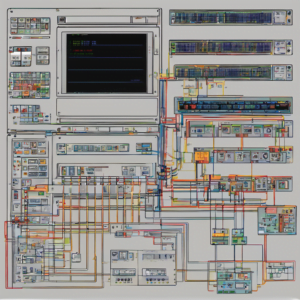In the ever-evolving landscape of technology, hardware plays a vital role in shaping the performance and capabilities of electronic systems. Two prominent contenders in the world of hardware design are Application-Specific Integrated Circuits (ASICs) and Field-Programmable Gate Arrays (FPGAs). These two technologies offer distinct advantages and cater to different requirements, making it crucial for designers and engineers to understand their differences and choose the right hardware for their specific applications.
ASICs are specialized integrated circuits designed for a specific purpose, tailored to meet the exact requirements of a particular task. These chips are customized to optimize performance, power consumption, and size for a specific application, providing exceptional efficiency. On the other hand, FPGAs are programmable devices that can be configured and reconfigured to implement desired logic and functionality. They offer flexibility and versatility, allowing designers to rapidly prototype and test designs without the need for costly and time-consuming fabrication processes.
In this blog post, we will delve into the comparison between ASICs and FPGAs, exploring their unique characteristics, strengths, and limitations. We will examine various factors such as performance, cost, development time, and design flexibility, helping you make informed decisions when choosing the appropriate hardware for your projects. By the end, you will have a comprehensive understanding of ASICs and FPGAs, enabling you to navigate the hardware landscape with confidence and maximize the potential of your applications.
ASICs: Customized for Specific Tasks
A. Definition and Functionality:
- ASICs, or Application-Specific Integrated Circuits, are specialized integrated circuits designed for a particular application or task.
- Unlike general-purpose processors, ASICs are tailor-made to efficiently perform a specific function.
- They are designed with a fixed circuitry layout optimized for a specific set of operations, resulting in high performance and power efficiency.
B. Advantages of ASICs:
- High Performance: ASICs are optimized for a specific task, allowing them to achieve higher performance levels compared to general-purpose processors or FPGAs.
- Power Efficiency: ASICs are designed to minimize power consumption by eliminating unnecessary components, resulting in energy-efficient operation.
- Cost-effectiveness for Mass Production: ASICs can be more cost-effective when produced in large quantities due to economies of scale.
C. Limitations of ASICs:
- High Development Costs: Designing and manufacturing ASICs involves significant upfront costs, including the cost of developing the design, fabricating the chip, and testing prototypes.
- Lack of Flexibility: ASICs have a fixed circuitry layout, making them difficult or impossible to reconfigure once manufactured. This lack of flexibility limits their adaptability to changing requirements or functionalities.
- Long Development Time: ASIC development involves various stages, such as designing the architecture, verifying the design, and fabricating the chip, which can be time-consuming compared to other options.
D. Use Cases:
ASICs find applications in industries that require high-performance, specialized hardware solutions.
- Consumer Electronics: ASICs are commonly used in devices like smartphones, gaming consoles, and digital cameras to achieve efficient processing of specific tasks like image processing, audio decoding, or encryption.
- Automotive: ASICs are utilized in automotive systems for functions like engine control, safety systems, and infotainment, where high performance and reliability are crucial.
- Telecommunications: ASICs play a vital role in networking equipment, enabling efficient data routing, protocol handling, and encryption for improved network performance.
By understanding the capabilities and limitations of ASICs, it becomes easier to assess whether they are the right choice for a specific application. In the next section, we will explore Field-Programmable Gate Arrays (FPGAs) as an alternative option and compare their characteristics to ASICs.
FPGAs: Programmable Hardware for Versatility
A. Definition and Functionality:
Field-Programmable Gate Arrays (FPGAs) are integrated circuits that can be configured and reconfigured after manufacturing. Unlike ASICs, which are designed for specific functions, FPGAs offer programmable logic resources, routing resources, and embedded memory blocks. This flexibility allows users to customize the FPGA’s functionality to suit their specific application needs.
B. Advantages of FPGAs:
FPGAs provide several advantages over ASICs in certain scenarios:
- Flexibility to reconfigure and update functionality: FPGAs offer the ability to modify the hardware configuration, enabling developers to adapt their designs to changing requirements without the need for redesigning and manufacturing new chips. This agility can be particularly useful in rapidly evolving industries or when iterative design processes are required.
- Rapid prototyping and time-to-market advantages: With FPGAs, designers can quickly implement and test their ideas, reducing the time needed to prototype a hardware system. This accelerated development cycle can be crucial in competitive markets where speed-to-market is paramount.
C. Limitations of FPGAs:
While FPGAs offer versatility, they also have certain limitations to consider:
- Higher power consumption compared to ASICs: FPGAs tend to consume more power than ASICs due to the programmable fabric and additional circuitry required for configuration flexibility. This higher power consumption may limit their use in power-constrained applications or battery-operated devices.
- Limited performance compared to specialized ASIC designs: ASICs, being application-specific, can be optimized for specific tasks, resulting in superior performance compared to FPGAs. For high-performance computing or applications demanding ultra-low latency, ASICs may be more suitable than FPGAs.
D. Use Cases:
FPGAs find applications in various industries and domains where their programmability and flexibility are advantageous:
- Aerospace and Defense: FPGAs are commonly used in avionics systems, radar signal processing, software-defined radios, and cryptographic applications due to their ability to adapt to changing standards and requirements.
- Data Centers: FPGAs are employed in data centers for tasks like accelerating machine learning algorithms, networking, and storage acceleration. Their reconfigurable nature enables data centers to optimize hardware resources based on workload demands.
- Internet of Things (IoT): FPGAs can be beneficial in IoT applications that require customization and adaptability to different sensor interfaces, communication protocols, or edge computing tasks.
- Prototyping and Emulation: FPGAs are widely used for rapid prototyping and emulation of ASIC designs. They allow designers to verify and validate their concepts before committing to the high costs of ASIC development.
By understanding the advantages, limitations, and use cases of FPGAs, designers can make informed decisions about when and where to utilize this programmable hardware. The flexibility and versatility of FPGAs make them an attractive option in various scenarios, offering a balance between customization and development efficiency.
ASICs vs FPGAs: A Comparative Analysis
A. Performance:
When comparing ASICs and FPGAs, performance is a crucial factor to consider. ASICs are designed for specific tasks and can achieve higher performance levels due to their optimized hardware implementation. They offer faster processing speeds, lower power consumption, and reduced latency compared to FPGAs. Since ASICs are tailor-made for a particular application, they can execute tasks more efficiently and reliably.
On the other hand, FPGAs provide a level of flexibility at the expense of performance. Their programmable nature allows for rapid prototyping and iterative development, but it introduces additional layers of logic that can impact performance. FPGAs typically have higher power consumption and longer latency compared to ASICs. However, advancements in FPGA technology have narrowed this performance gap in recent years.
B. Cost:
Cost is a significant consideration when deciding between ASICs and FPGAs. ASIC development involves high upfront costs, including design, verification, and mask fabrication. These costs can be prohibitive for low-volume or niche applications. However, for high-volume production, ASICs can offer significant cost advantages due to economies of scale. Once the ASIC design is finalized, the per-unit cost decreases, making ASICs more cost-effective in the long run.
In contrast, FPGAs have lower upfront costs compared to ASICs. They eliminate the need for mask fabrication and can be programmed and reprogrammed for different tasks. This makes FPGAs more suitable for low- to medium-volume production, rapid prototyping, and development iterations. However, the per-unit cost of FPGAs is generally higher than ASICs, making them less cost-effective for large-scale production.
C. Development Time:
Development time is another critical factor in choosing between ASICs and FPGAs. ASIC development involves a complex and time-consuming process that includes design, verification, and fabrication. The design phase alone can take months or even years, depending on the complexity of the application. ASICs are well-suited for applications where performance and efficiency are paramount, but they require a significant investment of time and resources.
FPGAs offer a distinct advantage in terms of development time. Their programmable nature allows for rapid prototyping and quicker iterations during the design process. Changes and updates to the design can be implemented by simply reprogramming the FPGA, saving time compared to modifying an ASIC design. FPGAs enable engineers to test and refine their designs more quickly, reducing time-to-market for new products.
D. Design Flexibility:
Design flexibility refers to the ability to modify and adapt the hardware implementation according to changing requirements. ASICs, once fabricated, offer minimal flexibility. The design is fixed and cannot be modified without going through the entire fabrication process again. This lack of flexibility is a trade-off for the optimized performance that ASICs provide.
FPGAs, on the other hand, excel in design flexibility. Their reprogrammable nature allows for modifications and updates to the logic without the need for physical changes. This feature is particularly beneficial during the prototyping and development stages when design iterations and adjustments are frequent. FPGAs can be reconfigured to adapt to evolving requirements, making them suitable for applications that demand flexibility and quick design iterations.
Overall, the choice between ASICs and FPGAs depends on the specific requirements of the application, cost considerations, development time constraints, and the need for design flexibility. ASICs offer high performance and cost-effectiveness for high-volume production, while FPGAs provide flexibility and faster development cycles. Evaluating these factors in the context of the application will help determine the most suitable hardware for the desired outcome.
Choosing the Right Hardware: Factors to Consider
A. Application Requirements:
When deciding between ASICs and FPGAs, it’s crucial to consider the specific requirements of your application. ASICs are ideal for applications that demand high performance, low power consumption, and specialized functionality. On the other hand, FPGAs provide greater flexibility, making them suitable for applications that require frequent design changes, prototyping, or the ability to reconfigure functionality.
B. Volume and Production Needs:
The volume of production plays a significant role in hardware selection. ASICs are more cost-effective for high-volume production due to their economies of scale. The upfront development costs of ASICs can be significant, but when the production volume is high, the cost per unit decreases. In contrast, FPGAs are more suitable for low-volume production or situations where the production quantity may vary.
C. Time-to-Market:
Time-to-market is a critical factor in many industries. ASIC development typically takes longer due to the design, fabrication, and testing phases. However, FPGAs offer a faster time-to-market advantage since they allow for rapid prototyping and iterative design. FPGAs enable developers to quickly test and validate their designs before committing to ASIC development, potentially saving valuable time.
D. Future Adaptability:
Consider the future adaptability of your design. ASICs are fixed and cannot be reconfigured after production, making them less adaptable to changing requirements. If your application is likely to undergo frequent updates or upgrades, FPGAs provide the flexibility to reconfigure the hardware and implement changes easily. FPGAs also allow for in-field firmware updates, enabling better long-term adaptability.
E. Cost:
Cost is a significant consideration when choosing between ASICs and FPGAs. ASIC development involves substantial upfront costs, including design, verification, and fabrication expenses. However, for high-volume production, ASICs offer cost advantages due to lower per-unit costs. FPGAs, although more expensive per unit, have lower upfront costs and are better suited for low-volume production or scenarios where design iterations are frequent.
F. Design Flexibility:
Design flexibility is another crucial factor. ASICs are highly optimized for specific tasks and provide excellent performance but lack the ability to adapt or reconfigure. FPGAs, being programmable hardware, offer more design flexibility and can be reprogrammed to accommodate changing requirements or design iterations. FPGAs are especially valuable in situations where experimentation, optimization, or quick design changes are necessary.
G. Expertise and Resources:
Consider the expertise and resources available to your development team. ASIC design requires specialized skills and knowledge in areas such as digital design, verification, and physical layout. Developing ASICs often requires access to foundries and fabrication facilities. In contrast, FPGAs can be programmed using high-level languages and development tools, making them more accessible to a wider range of engineers and designers.
Conclusion:
Choosing between ASICs and FPGAs requires careful consideration of factors such as application requirements, volume and production needs, time-to-market, future adaptability, cost, design flexibility, and available expertise. ASICs excel in high-performance, power-efficient, and high-volume production scenarios, while FPGAs offer flexibility, rapid prototyping, and adaptability. Evaluating these factors will help you make an informed decision that aligns with the unique needs of your project or application.


![What is FPGA Introduction to FPGA Basics [2023] computer-chip-dark-background-with-word-intel-it](https://fpgainsights.com/wp-content/uploads/2023/06/computer-chip-dark-background-with-word-intel-it-300x171.jpg)









